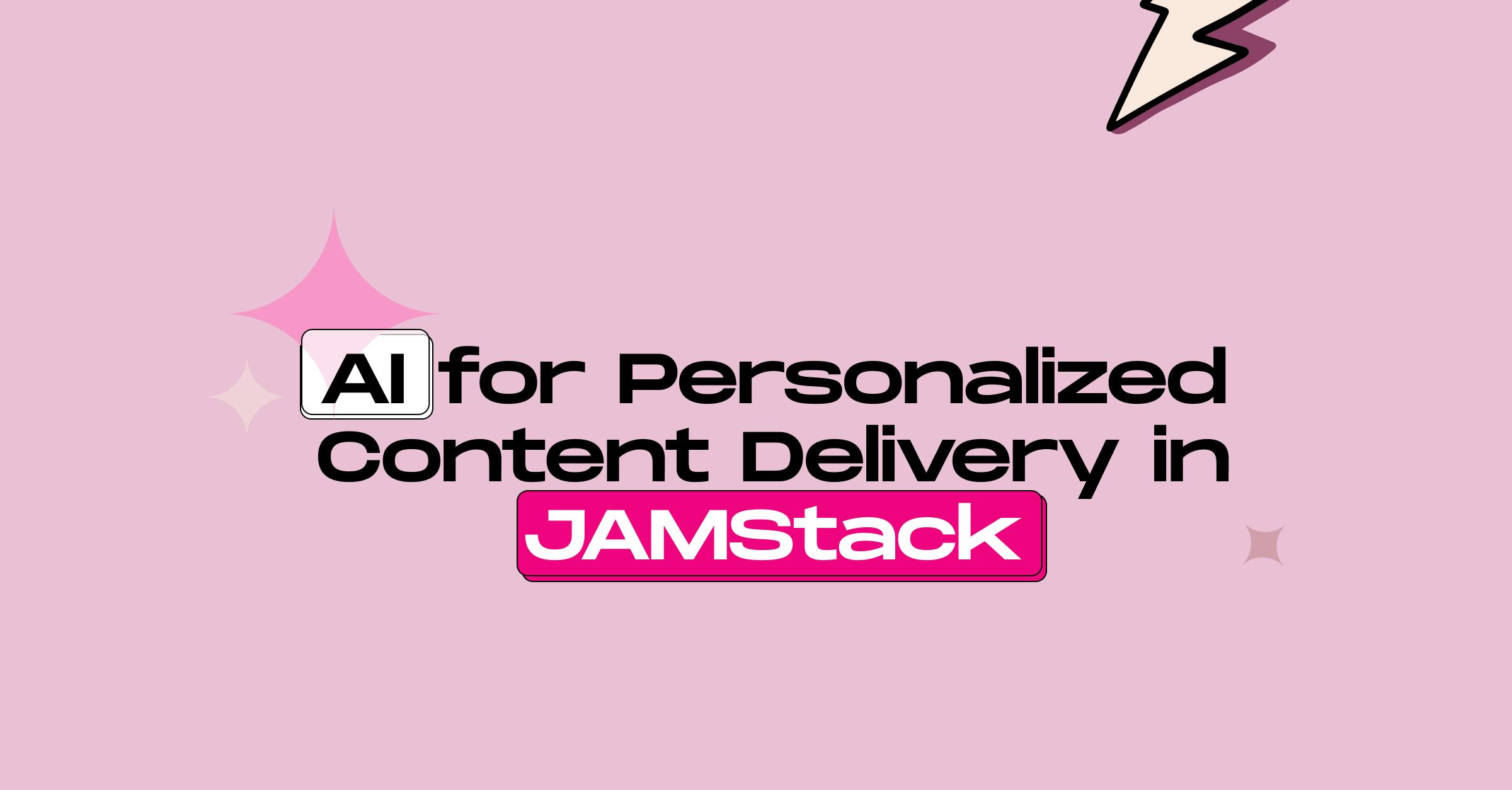July 17, 2025
AI for Personalized Content Delivery in JAMStack Applications in 2025

Rifat Nawaz

Imagine landing on a website that feels like it was built just for you, products you love, articles that match your interests, or a layout that adjusts to your preferences. In 2025, this isn’t a dream; it’s the power of artificial intelligence (AI) combined with JAMStack architecture. With 80% of consumers more likely to engage with brands offering tailored experiences (Epsilon, 2024), personalization is a must. JAMStack, built on JavaScript, APIs, and Markup, delivers fast, secure, and scalable websites. By weaving AI into this framework, developers can create dynamic, user-specific content without sacrificing speed.
This article examines the application of AI for personalized content delivery in JAMStack applications, highlighting the top tools and trends of 2025 to captivate US readers and improve your site’s performance.
Why Personalization Matters in JAMStack
JAMStack applications excel due to their static-first approach, serving pre-rendered HTML via Content Delivery Networks (CDNs) for speedy load times. But static sites can feel one-size-fits-all without personalization. AI changes that deliver tailored content while keeping JAMStack’s performance edge. In 2025, personalization delivers:
- Higher Engagement: Tailored content boosts time-on-site by an average of 20% (Forbes, 2025).
- Better Conversions: E-commerce sites with AI-driven recommendations see up to 30% higher conversion rates (McKinsey, 2025).
- Improved User Experience: From product suggestions to localized interfaces, personalization makes users feel understood and valued.
With trends like edge computing, headless CMS, and composable architectures surging, headless CMS adoption is increasing by 25% annually (Netguru, 2025), AI is transforming the JAMStack into a hub for dynamic, user-centric experiences.
How AI Enhances JAMStack Applications
AI supercharges JAMStack by analysing user data in real-time and delivering customised content through APIs and edge functions. Key applications include:
- Content Recommendations: Suggesting products, articles, or videos based on browsing history.
- Dynamic Interfaces: Adjusting layouts, themes, or navigation to match user preferences.
- Intelligent Search: Delivering context-aware search results with tools like Algolia.
- Automated Content: Generating summaries or metadata to boost SEO.
- Localization: Adapting content to a user’s language, region, or culture.
These align with 2025’s web development landscape, where edge computing and AI-driven personalization are reshaping how websites engage users (Jamstack in 2025).
2025 Trends Powering AI in JAMStack
This year’s trends make AI and JAMStack a perfect pair:
- Edge Computing: Netlify and Cloudflare’s edge functions reduce latency, with 75% of enterprise data expected to be processed at the edge by 2026 (Gartner, 2025).
- Composable Architecture: Headless CMS like Sanity and backendless platforms like Supabase enable modular content delivery.
- AI-Powered Search: Algolia’s AI search boosts click-through rates by 20% (Algolia, 2025).
Eco-Friendly Design: AI optimizes content delivery, reducing energy use by 30% through the use of CDNs (Netlify, 2025).
Real-World Success Stories
- E-commerce: A Shopify store utilizing Next.js and Algolia increased conversions by 25% with AI-driven product recommendations (Shopify Case Study, 2025).
- Content Sites: A media outlet with Gatsby and Sanity increased time on-site by 15% with personalized article suggestions (Sanity Case Study, 2024).
- Marketing: A SaaS company using Netlify Edge Functions to tailor landing pages by location, lifting leads by 20% (Netlify, 2025).
Challenges and Fixes
Personalised content delivery on JAMstack architecture introduces a set of technical and operational challenges, especially as you scale. Over the years, StaticMania has helped startups and enterprise clients navigate these hurdles with proven methods and modern tooling.
Challenge 1: Slower Build Times on Content-Rich Sites
Sites with multiple user segments or location-specific content can see significantly longer static build times, which slows down development cycles and increases deployment risks.
How to Fix It:
We implement Incremental Static Regeneration (ISR) and use selective on-demand revalidation in platforms like Next.js. For fast-changing segments, we design API-based rendering pipelines and serverless functions that handle personalization without increasing the size of static builds. This hybrid approach ensures fast deploys without compromising dynamic delivery.
Challenge 2: Privacy and Consent Compliance
As personalisation requires tracking some level of user behaviour, there’s a fine balance between relevance and compliance, especially with laws like GDPR and CCPA.
How to Fix It:
We help clients integrate consent management tools, such as OneTrust or Cookiebot, enabling granular control over data collection. Our implementations often rely on first-party data models, using anonymized session identifiers and privacy-respecting logic at the edge. Clients retain user trust without sacrificing marketing performance.
Challenge 3: SEO Limitations with Dynamic Content
Dynamic components powered by JavaScript can impact crawlability and indexing, putting organic search traffic at risk if not managed properly.
How to Fix It:
We utilise server-side rendering for SEO-critical pages, complemented by dynamic sitemap generation, to ensure all content is accessible to search engines. Our team builds meta-aware templates that support Open Graph, structured data, and canonical tagging, even when content is customized in real-time.
The result: better rankings and discoverability without bloated scripts.
With a track record of successful JAMstack migrations and content-personalised deployments, StaticMania brings deep technical know-how and platform-agnostic strategy to every project. Whether you’re optimising an e-commerce storefront or scaling a content hub, our team ensures that personalisation doesn’t slow you down; it sharpens your edge.
Conclusion
In 2025, blending AI with JAMStack applications unlocks a world of personalized content, from intelligent product recommendations to tailored interfaces. Tools like Algolia, Sanity, and Netlify Edge Functions make it easy to deliver fast, secure, and engaging experiences. Whether you’re running an online store, a blog, or a marketing site, AI-driven personalization can set your JAMStack application apart. Start small, test thoroughly, and watch your user engagement soar.
Ready to personalize your site? Reach out to StaticMania for expert help building AI-powered JAMStack applications.
FAQs
AI-driven personalization in JAMStack apps refers to using artificial intelligence to deliver dynamic, user-specific content on static sites. By analyzing real-time user behavior, AI tools recommend content, adjust layouts, and localize interfaces—all while preserving JAMStack's speed and performance advantages through the use of APIs, edge functions, and headless CMS integrations.
AI enhances JAMStack websites by tailoring content to user preferences. This includes personalised product recommendations, context-aware search results, adaptive layouts, and location-based interfaces. These features lead to increased engagement, higher conversion rates, and a more intuitive user experience, without sacrificing loading speed.
Popular tools in 2025 for AI personalization in JAMStack include:
- Algolia AI for intelligent search
- Sanity and Contentful as headless CMS platforms
- Netlify Edge Functions for real-time content delivery
- Supabase for backend logic
- Vercel’s Edge Middleware for segment-based rendering
These tools allow fast, scalable, and personalised delivery with minimal latency.
Yes, if not implemented correctly. JavaScript-rendered content can hinder crawlability. To protect SEO, developers should use server-side rendering (SSR) for critical pages, implement dynamic sitemaps, and add structured data. Tools like Next.js with Incremental Static Regeneration (ISR) help strike a balance between SEO needs and personalized delivery.
AI personalization can be compliant with GDPR and CCPA if properly configured. Best practices include using first-party data, anonymized session tracking, and integrating consent management tools like OneTrust or Cookiebot. Edge-based logic can further ensure compliance without sacrificing performance or accuracy.
Key challenges include longer build times, privacy compliance, and SEO issues. Solutions involve:
- Using ISR and on-demand revalidation
- Building privacy-first consent layers
- Applying server-side rendering for SEO-sensitive pages
Partnering with experts like StaticMania ensures these technical hurdles are managed with platform-agnostic strategies and proven tooling.

